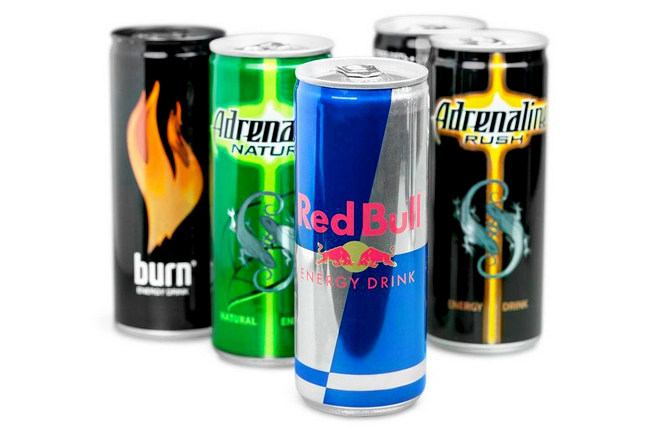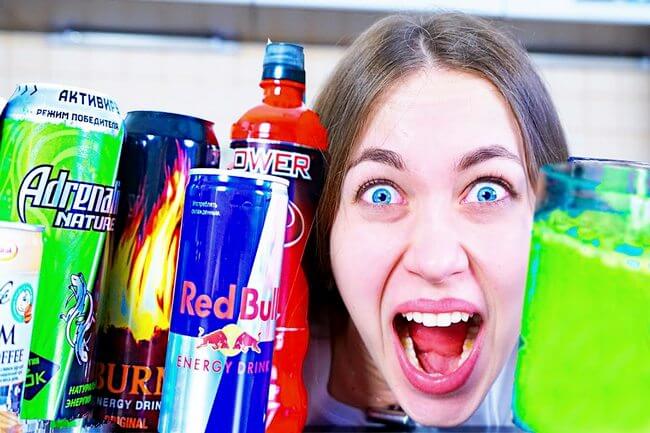Drinks of the third millennium — this is how energy drinks are called, which, indeed, enjoy great popularity. Students, who have to spend nights on end on their school projects; young people, who spend their time in clubs; truck drivers, security guards, watchmen, and other people, who work around the clock; those who have to go to the gym after a hard day at work — this is far from a complete list of those who consume them.
Despite the fact that the media often warns about the harmful effects of energy drinks on the body, they continue to remain sales leaders. So what do they bring more — benefits or harm?
General information

Energy drinks are beverages with a pronounced tonic, antisedative effect due to the content of natural psychostimulants. Recommended for use for a quick recovery of strength, getting rid of fatigue and drowsiness. They are mainly consumed by those who need to refrain from sleep or double their energy for several hours.
Many people believe that this is a discovery of the 21st century, but this is not true. Their analogues can be found in the works of ancient herbalists. In particular, one of the books of the famous German abbess Hildegard von Bingen (12th century) describes a recipe for an elixir that gives vitality.
In the form in which we know them now, they appeared a century ago. In 1927, Lucozade was created in the UK for the accelerated recovery of patients with a composition typical of modern energy drinks: carbon dioxide, glucose syrup, citric and lactic acids, caffeine, sodium benzoate and bisulfate, vitamin B9.
On its basis in 1962 in Japan, a new drink Lipovitan was created, which began to be sold not as a drug for accelerated recovery, but as a stimulating drink that prevents sleep for several hours and provides a surge of strength and vigor. Since then, the production of energy drinks in the East has been put on stream.
In Europe, this was initiated by the Austrian entrepreneur Dietrich Mateschitz, who borrowed the recipe while vacationing in Hong Kong. Embellishing it with modern, more advanced components, he created a completely new product Red Bull, which eventually made him one of the richest people on the planet. The brand has a scandalous reputation, but to this day it is incredibly popular all over the world.
In 1985, energy drinks took over America, thanks to Jolt Cola, which was recommended to students and people in professions that require prolonged mental and physical exertion. In 1995, it was replaced by Josta from PepsiCo, on the basis of which Adrenaline Rush began to be produced since 1999.
In New Zealand and Australia, the sales leaders are beverages from Frucor Beverages.
The sales volume today is more than $50 billion.
Many people are interested in the question of how old energy drinks are sold. If they do not contain alcohol, in the territory of the Russian Federation they can be freely sold to people of any age, including children and adolescents. This is not prohibited by law. The exception is the Moscow region, where such drinks cannot be sold to minors from 01.05.2015.
Effect on the body
Since the mass production of energy drinks was launched, there has been a lot of talk about what effect they have on human health. To understand what is more in them — benefits or harm, you need to know which systems and organs they act on and how exactly they do it.
Properties:
- they tone — they raise the vitality, providing a state of prolonged excitation of the nervous system and muscle tissue without fatigue;
- they stimulate the central nervous system — they cause an increase in its activity, accelerate its functioning;
- they provide an antisedative effect — they cheer up, relieve drowsiness and lethargy, prevent falling asleep.

Thanks to these properties, after consuming the drink for 2-4 hours (the duration of the effect depends on the individual characteristics of the body):
- the mood rises sharply to the point of euphoria;
- a surge of strength, vigor, and energy is felt;
- you don’t feel like sleeping;
- performance increases;
- indicators of strength and endurance improve;
- cognitive activity is activated;
- the desire for physical activity increases.
A person experiences all this within 5-10 minutes after consumption. But the medal also has a second, less noticeable side.
It seems to everyone that energy drinks themselves are a source of energy. This is not true. The active substances that make up them are stimulants that act according to a simple scheme: they are quickly absorbed into the blood, excite the nervous system, forcing the body to expend its own energy in a double dose and then carry it through the cells. That is, they do not supply it, but take it in large quantities from the person himself.
An example for clarity and comparison. A loader has to unload 4 cars in an 8-hour working day. He can do this by evenly distributing the load — 1 car in 2 hours. At the same time, he will take breaks for rest and as a result will feel only slight fatigue at the end of the working day. But he can do otherwise: unload all 4 cars in 2 hours, working quickly, without restoring strength. As a result, he will exhaust all the reserves of his body, and by the end of the second hour he will feel bad.
The same thing happens with the body, which in its normal state distributes the available energy evenly. Energy drinks force him to spend it all in a short period of time. It is not difficult to guess what will happen when the effect ends: exhaustion, decline in strength, poor health — and this is not the whole list of sensations that you will have to experience after euphoria.
So the effect of energy drinks on the human body is a vivid example of a double-sided medal. On the one hand, there is a surge of strength and an incredible surge of vigor, when you want to move mountains. But behind this lies the complete exhaustion of the body and nervous system after a few hours.
Composition
The effect of energy drinks on the body is dictated by the active substances that make up them. The base is the same for almost all brands with minor deviations.
Essential active ingredients:
- glucose — the main energy extractor from the body;
- taurine — an amino acid that accelerates energy processes in the body;
- caffeine — a psychostimulant alkaloid that tones the central nervous system and cardiac activity, accelerates the pulse, causes vasodilation, increases intellectual and physical performance, eliminates drowsiness;
- guarana — a vine, the extract of which contains a large amount of caffeine, uplifting, and invigorating;
- ginseng — a natural psychostimulant;
- nicotinic acid (vitamin B3) stabilizes the functioning of the nervous system;
- pantothenic acid (B5) participates in the restoration of nerve tissues;
- pyridoxine (B6) has a regulating effect on the nervous system;
- folic acid (B9) increases the production of serotonin and norepinephrine in the body, which improve mood;
- ascorbic acid (C) delivers glucose to its destination, participates in the production of serotonin.
This is not counting the preservatives, dyes, and carbonic acid, which makes them carbonated. Caffeine and glucose are essential ingredients. Taurine is found in 75% of drinks.
At first glance, the lineup may seem balanced: some ingredients tone the nervous system, while others soothe and stabilize it. In fact, the first ones are several times larger than the second ones. Manufacturers use only 1-2 vitamins, and in minimal quantities.
Harm
Why do the media constantly talk about the fact that energy drinks are dangerous? At one time (2009-2010), Red Bull was banned in a number of countries due to the fact that elements of cocaine were allegedly found in it. The examination subsequently refuted this fact, but a wave of indignation and protests was launched.
